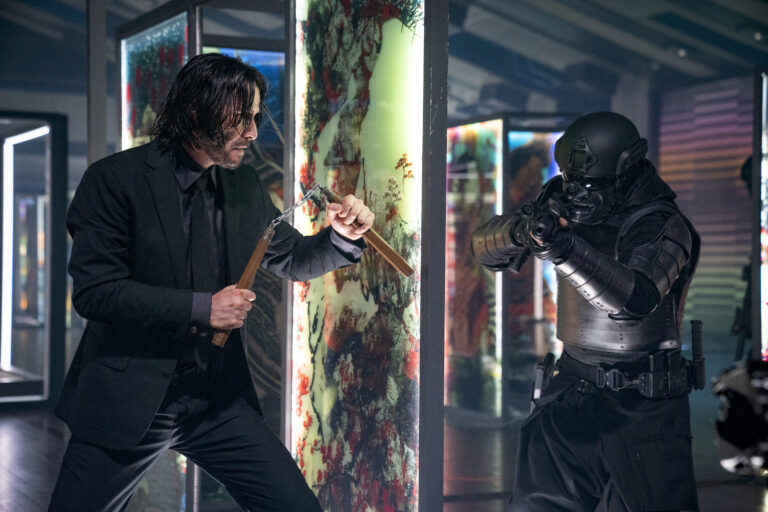John Wick: Chapter 4 (2024 | USA | 169 minutes | Chad Stahelski)
After filming delays to accommodate its star’s obligations to another four-part franchise followed by pandemic shutdowns and shifted release dates, it is at long last time to crack open the fourth volume in the ongoing stories of one Jonathan Wick, lover of dogs and indestructible super-assassin, who despite being the best he is at what he does has been increasingly desperate to not do it any more. One might worry that so many postponements portend disappointment, but set those trepidations aside. Like their dark hero, director Chad Stahelski and his indefatigable star Keanu Reeves are incredibly good at what they do: conducting symphonies of stylized violence that make three hours disappear in a flurry of awestruck wonder.
Taking a cue from Keanu, who maybe utters a hundred words in total during the film’s 169 minutes, the less spoken of the plot, hinging on the vague mythology of an ancient society of underground assassins, the better. It’s not bad, per se, but the more that series regular Ian McShane (a creaky delight of decorum, as usual) is trotted out to make pronouncements on the codes of conduct and oaths underlying their murderous arts, the less any of the spectacular action sequences make sense. But, despite being the motivation for a spin-off prequel, the rites, customs, and rules are only a McGuffin. The true guiding principle of all of these movies is that everything should look as awesome as possible all the time. Nothing else really matters, and the experience is all the better for it.
Nevertheless, as the movie opens John Wick finds himself recovered from the events of the last film, trained up in Laurence “Bowery King” Fisher’s underground lair, freshly outfitted with a dapper and bulletproof suit, and ready to resume his vendetta against “the High Table” for refusing to grant him freedom from a life of contract killing (which has made him the target of an uncountable number of contract killers). While McShane’s “hotelier” Winston and devoted Concierge Charon (Lance Reddick, stately in what sadly became his final role) remain in New York to face harsh consequences for the actions of the last film, John’s leapfrogs the globe looking for a way out (via incredible flourishes of balletic violence).
It’s the perfect setup for a travelogue, where one can only hope that the production team received lots and lots of kickbacks and cooperation for making each stop look like a gorgeously saturated picture-perfect postcard. Each city acts as a fresh wanderlust-inspiring canvas, even though it’s one left spattered by tasteful puffs of kill shots and littered with a trail of dead assassins. After concluding an epic desert sequence recalling a previous film’s equestrian delights, most of Wick’s adventures happen under the dramatic cover of night — all the better for the backdrops of neon tubes, strobing club lights, and the incandescent glow of city streets — as he marches toward a fateful sunrise confrontation with a newly-introduced antagonist.
Towering in the background, outfitted in aristocratically-tailored garb just the right side of gaudy to coordinate perfectly with each of his opulent lairs, is Bill Skarsgård (yes, there is another) as a Marquis of some sort, intent on ascending higher on the High Table by proving his worth in an agent-of-chaos campaign to finally kill John Wick dead. He’s the sort of guy who conducts interviews with potential assassins between horseback riding, takes his espressos in closed off corridors of the Louvre, sets his terms of engagement on a shiny granite table on steps of the Trocadéro overlooking the Eiffel Tower, and plots his endgame using a scale model of the city assembled for him in a courtyard at the Fondation Louis Vuitton with Frank Gehry’s swoopy architecture as modern evil-doer backdrop. I can see why the Stahelski hired this Swede who made his name as IT’s nightmare clown as his chief antagonist. He has a ton of fun with the role.
As John flits from place-to-place, catching up (and immediately endangering) old friends, killers in the Marquis employ find him, giving Stahelski opportunities for invention in improbably fun ways to show us dozens of people being killed. In Osaka, at another outpost of the Continental (preferred by ten out of ten assassins), John catches up with Shimazu (Hiroyuki Sanada) and we meet his daughter (played admirably by pop star Rina Sawayama) before being discovered by old colleague / new reluctant enemy Caine, a blind assassin portrayed with effortless cool by legendary martial arts star Donnie Yen. Also hot on his trail with uncertain allegiances is one Mister Nobody (Shamier Anderson) and his loyal killing machine dog, who’s the smiliest, murderiest, goodest Malinois who steals every scene. The hotel is the site of a brilliant series of confrontations with creepily-masked police-style assassins that employ guns (of course, so many lifted from enemies to replace exhausted armaments) but also traditional weapons like swords, arrows, and even nun-chucks through neon cube galleries, glowing escalators, and in traditional Japanese gardens.
Berlin finds Wick calling in favors in Roma temples, cutting deals with a sweaty asthmatic gold-toothed poker player, and cutting through a pulsing club of brutalist architecture and waterfalls. The shadowy action and everyone’s ability to survive falls from great heights becomes somewhat Looney Tunes but the real humor is in how long it takes the dance-all-night stereotypically German revelers to pay the killing spree the slightest notice. The art of each of these sequences is in how the camera finds the rhythm of each place and style of fighting while the direction guides the audience through so much violence that initial shock leads to waves of overwhelmed tedium and then rounds the corner into a rare concoction of humor, thrill, and delight via sensory overload. The choreography is masterful and the filmmakers perfectly time the refractory lulls between them so that we’re ready for next stage on the quest to the big bad to inevitably ascend to new heights.
For me, the spell only started to break when the Paris-set sequence finds extreme gunplay and car crashes erupts into the streets in a sequence that culminates in a deadly sequence encircling the Arc de Triomphe. Whether it was the timing of where it fell in the film or the stark contrast of real places vs. the constructed fantasies of Assassin World, it was the only part where the runtime and mass violence started to drag. The ship rights itself quickly with a race through abandoned houses with overhead camerawork that plays like a classic video game, except with hilariously updated weapons and special effects. In any other context, you might recoil in horror at people being set aflame, brutally bludgeoned, or assassinated at close range, but at this cartoonish level it becomes something else entirely, beyond desensitization to a marvelous laugh-out-loud and cheer at the audacity of the choreography of killing that exists only in this cinematic universe. Plus, there are so many instances of kicks to the groin you can’t not chuckle.
In part because although Keanu plays the character with such deadpan exhaustion, his few-and-far-between utterances and his haunted looks of desperation are deployed with much precision as his kill shots or punches. The internal mythology is stilted, ridiculous, and often self-contradictory, but moments to dwell on the ceremonious nature of this old society of killers are few and far between. It really doesn’t matter, because we are somehow on the side of this superhero that Keanu Reeves has created and sustained through sneaky laconic charisma and a commitment to punishing his own body well into his fifth decade. How could we not be on the side of more, more more? The extremely outlandish odds and improbability only endear us further as he wills himself toward a sunrise ritual confrontation with destiny.
John Wick: Chapter 4 arrives in theaters on March 24
Header image courtesy Lionsgate.



